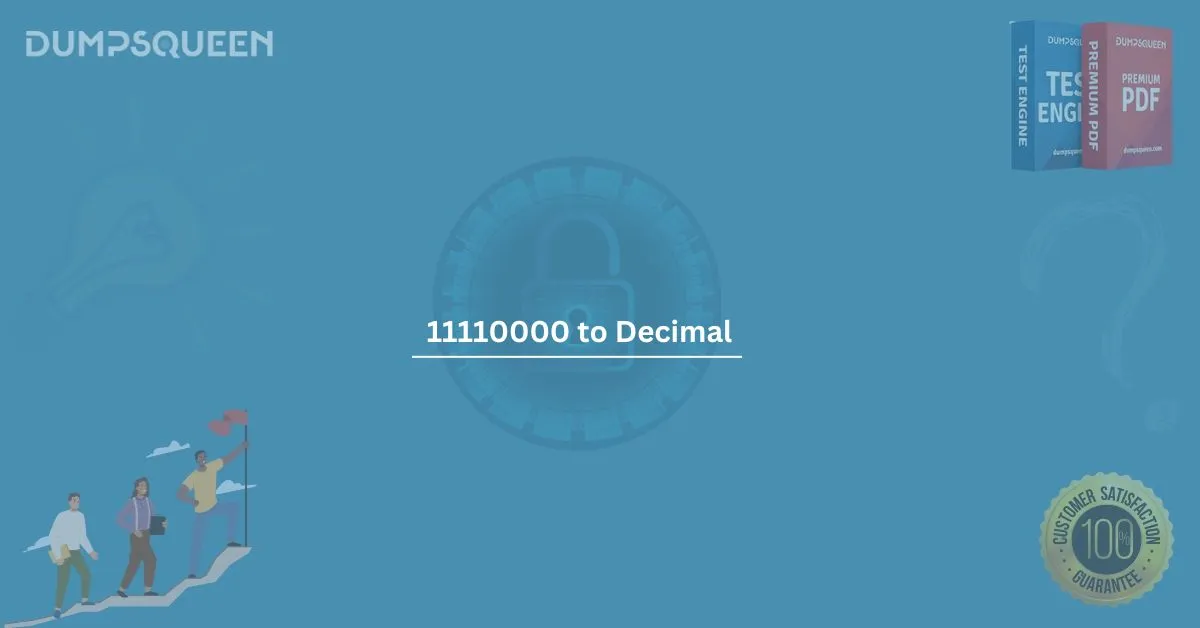When you’re dealing with binary numbers, converting them to decimal form is an essential skill, especially for anyone working in fields related to computer science, programming, or IT systems. Understanding how to convert binary numbers into decimal form can make a big difference when you're working with low-level computing tasks, networking, or simply understanding how machines process data.
In this blog, we will walk you through the process of converting "11110000" from binary to decimal, explore how binary-to-decimal conversions work, and provide you with some sample questions to help solidify your understanding. Additionally, we will discuss some essential tips and tricks to ease the process for students and professionals preparing for technical exams.
What is Binary and Decimal?
Before diving into the conversion process, let's briefly define binary and decimal numbers.
- Binary is the base-2 numeral system. It consists of only two digits: 0 and 1. Binary is the language that computers speak, as it corresponds directly to the on/off states of the machine's hardware components.
- Decimal is the base-10 numeral system, which is what we use in our daily lives. It uses ten digits: 0, 1, 2, 3, 4, 5, 6, 7, 8, 9. Decimal numbers are what we are most familiar with, from counting money to measuring distances.
In binary, each digit represents a power of 2, while in decimal, each digit represents a power of 10. The goal of converting "11110000" to decimal is to understand the equivalent decimal value by interpreting each binary digit’s weight.
Converting Binary "11110000" to Decimal
Let’s break down how to convert the binary number "11110000" into decimal.
- Write down the binary number:
11110000 - Assign powers of 2 to each digit from right to left, starting with 202^020:
- 27,26,25,24,23,22,21,202^7, 2^6, 2^5, 2^4, 2^3, 2^2, 2^1, 2^027,26,25,24,23,22,21,20
This gives us the following sequence of powers of 2:
- 27=1282^7 = 12827=128
- 26=642^6 = 6426=64
- 25=322^5 = 3225=32
- 24=162^4 = 1624=16
- 23=82^3 = 823=8
- 22=42^2 = 422=4
- 21=22^1 = 221=2
- 20=12^0 = 120=1
- Now, apply the binary digits to each power of 2:
- The first digit (from the left) is 1, so we multiply 1×27=1281 \times 2^7 = 1281×27=128.
- The second digit is 1, so we multiply 1×26=641 \times 2^6 = 641×26=64.
- The third digit is 1, so we multiply 1×25=321 \times 2^5 = 321×25=32.
- The fourth digit is 1, so we multiply 1×24=161 \times 2^4 = 161×24=16.
- The remaining digits are 0, so they don’t contribute to the total value.
- Now, add up the results:
- 128+64+32+16=240128 + 64 + 32 + 16 = 240128+64+32+16=240
Thus, the binary number "11110000" is equivalent to 240 in decimal.
Why is This Important?
Understanding how to convert binary numbers into decimal form is crucial for several reasons:
- Computer Science: Binary is the language of computers. When you work with binary numbers, especially in low-level programming or hardware design, converting between binary and decimal is often required.
- Networking: IP addresses, subnet masks, and other networking-related components often require conversions between binary and decimal numbers.
- Programming: When dealing with bitwise operations, binary numbers are common. Being able to understand their decimal equivalents is essential when debugging or optimizing code.
Knowing how to convert binary to decimal enhances your understanding of how computers store and process data, making it an important skill in any tech-related field.
Tips for Converting Binary to Decimal
- Start with the leftmost bit: Begin from the leftmost digit and assign the corresponding powers of 2 to each digit.
- Focus on non-zero bits: Only focus on the bits that are set to 1, as these are the ones that contribute to the final decimal value.
- Practice makes perfect: Keep practicing converting different binary numbers into decimal to speed up your ability to perform conversions quickly and accurately.
- Use online tools: If you’re studying for an exam or working on a large project, there are many online binary-to-decimal converters that can help you double-check your work.
Conclusion
The conversion from binary to decimal is a fundamental concept in computing and programming. Mastering this skill allows you to better understand how data is processed in computer systems and networks. Whether you're preparing for an exam or simply expanding your knowledge in tech-related fields, understanding how to convert binary numbers into decimal will help you make sense of the data-driven world.
For those studying for technical exams, focusing on topics like binary and decimal conversion is key. With consistent practice, you can become proficient in converting between numeral systems, improving your overall understanding of technology.
Practice with Sample Questions
To help solidify your understanding, here are a few practice questions based on the conversion process:
Question 1:
What is the decimal equivalent of the binary number "10101010"?
- A) 170
- B) 128
- C) 255
- D) 85
Answer:
The correct answer is A) 170.
Explanation:
For "10101010", the binary number corresponds to the following powers of 2:
27+25+23+21=128+32+8+2=1702^7 + 2^5 + 2^3 + 2^1 = 128 + 32 + 8 + 2 = 17027+25+23+21=128+32+8+2=170.
Question 2:
What is the decimal equivalent of the binary number "10011001"?
- A) 202
- B) 153
- C) 133
- D) 115
Answer:
The correct answer is B) 153.
Explanation:
For "10011001", the binary number corresponds to the following powers of 2:
27+24+23+20=128+16+8+1=1532^7 + 2^4 + 2^3 + 2^0 = 128 + 16 + 8 + 1 = 15327+24+23+20=128+16+8+1=153.
Question 3:
Convert the binary number "11100011" to decimal.
- A) 235
- B) 226
- C) 232
- D) 243
Answer:
The correct answer is D) 243.
Explanation:
For "11100011", the binary number corresponds to the following powers of 2:
27+26+25+21+20=128+64+32+2+1=2432^7 + 2^6 + 2^5 + 2^1 + 2^0 = 128 + 64 + 32 + 2 + 1 = 24327+26+25+21+20=128+64+32+2+1=243.
Limited-Time Offer: Get an Exclusive Discount on the 200-301 Study Guide Material – Order Now!



